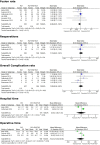Posterolateral Fusion Versus Interbody Fusion for Degenerative Spondylolisthesis: Systematic Review and Meta-Analysis
- PMID: 28811993
- PMCID: PMC5544162
- DOI: 10.1177/2192568217701103
Posterolateral Fusion Versus Interbody Fusion for Degenerative Spondylolisthesis: Systematic Review and Meta-Analysis
Abstract
Study design: Systematic review and meta-analysis.
Objective: Current surgical management of degenerative spondylolisthesis (DS) involves decompression of the spinal canal followed by fusion with or without interbody. The additional functional and operative benefits derived from interbody inclusion has yet to be thoroughly established with a number of recent studies producing conflicting results. Thus, we aim to compare the functional and operative outcomes after fusion against interbody fusion in the treatment of DS.
Methods: This systematic review of the literature comparing posterolateral fusion (PLF) and posterior lumbar interbody fusion (PLIF) outcomes in the treatment of DS was performed using the Preferred Reporting Items for Systematic Reviews and Meta-Analyses (PRISMA) guidelines. Electronic searches of 6 databases yielded 386 articles from database inception to July 2016, which were screening against established criteria for inclusion into this study.
Results: A total of 6 studies, satisfied criteria and reported outcomes for 721 patients. Fusion alone was performed in 458 (63.5%) patients and interbody fusion was performed in 263 (36.5%) patients. Functional outcomes Oswestry Disability Index (P = .29) and visual analog scale (P = .13) were not statistically different between the 2 approaches. Furthermore, there was no significant inferiority between fusion alone and with interbody in terms of the operative outcomes of blood loss (P = .38), reoperation rate (P = .66), hospital stay (P = .96), complication rate (P = .78), or fusion rate (P = .15).
Conclusions: There was no statistically significant difference in functional and operative outcomes following fusion alone versus with interbody. Additional subgroup analysis of intrinsic DS features in future large, prospective, randomized controlled trials will improve the validity of these findings.
Keywords: degenerative spondylolisthesis; interbody fusion; posterolateral fusion; spine; spondylolisthesis; systematic review.
Conflict of interest statement
Declaration of Conflicting Interests: The author(s) declared no potential conflicts of interest with respect to the research, authorship, and/or publication of this article.
Figures




References
-
- Koreckij TD, Fischgrund JS. Degenerative spondylolisthesis. J Spinal Disord Tech. 2015;28:236–241. doi:10.1097/BSD.0000000000000298. - PubMed
-
- Schroeder GD, Kepler CK, Kurd MF, et al. Rationale for the surgical treatment of lumbar degenerative spondylolisthesis. Spine (Phila Pa 1976). 2015;40:E1161–E1166. doi:10.1097/BRS.0000000000001116. - PubMed
-
- Steiger F, Becker HJ, Standaert CJ, et al. Surgery in lumbar degenerative spondylolisthesis: indications, outcomes and complications. A systematic review. Eur Spine J. 2014;23:945–973. doi:10.1007/s00586-013-3144-3. - PubMed
-
- Ghogawala Z, Dziura J, Butler WE, et al. Laminectomy plus fusion versus laminectomy alone for lumbar spondylolisthesis. N Engl J Med. 2016;374:1424–1434. doi:10.1056/NEJMoa1508788. - PubMed
Publication types
LinkOut - more resources
Full Text Sources
Other Literature Sources

